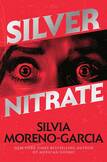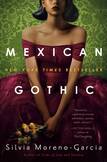Review: Silvia Moreno-Garcia’s books continue to cast a spell over readers.
Anyone who received an illustrated book of saints for their first Communion, with depictions of St. Lucy holding out a platter with her eyeballs on it and St. Sebastian writhing and arrow-pierced, can appreciate how early exposure to gory images of suffering saints might spark ideas for a future horror writer. The horror author creating the biggest stir across several countries in recent years is Silvia Moreno-Garcia. She grew up steeped in Catholicism in Mexico, and although she does not practice the religion, her novels are replete with themes, images and rituals that echo Catholic belief, ceremony and iconography, including her ninth and newest novel, Silver Nitrate, and her lush and gripping 2020 novel, Mexican Gothic.
In a Nightmare Magazine interview with Xander Odell from 2017, Moreno-Garcia spoke about the inspiration for her story “Jade, Blood”:
I was never into Catholicism, but I did read my Bible ferociously because it had all these gory, sexy and horrible stories. It’s the same with the saints. Agatha of Sicily is shown in paintings holding a dish with her breasts.... And it’s just odd how Indigenous beliefs bleed in and out of Mexican Catholicism. You look at something like the cult of Maximón, which is a sort of blend of pre-Hispanic ideas about gods and Catholic saints, and you end up concluding the world is strange and you know nothing about it.
After growing up in Mexico, Silvia Moreno-Garcia moved to Canada in 2003, and she currently lives in Vancouver, B.C. Moreno-Garcia is a prolific author, covering genres including horror, historical fiction, fantasy, noir and combinations of all of the above. In 2014, she published a collection of stories and has been churning out books ever since. While Moreno-Garcia earned acclaim in the horror and fantasy communities for each of her books, she first broke through to a mainstream audience in 2020 with Mexican Gothic, which became an American best-seller and won British and Canadian awards for best fantasy novel of the year.
How does Moreno-Garcia cast a spell over so many readers, including those who do not normally read horror?
How does Moreno-Garcia cast a spell over so many readers, including those who do not normally read horror? Several of her novels feature complicated heroines, compelling plots and supernatural elements solidly grounded in research—including mycology, anthropology and colonialist views in the case of Mexican Gothic, and Mexican film history, witchcraft and Nazis in the case of Silver Nitrate.
In Mexican Gothic, the Mexico City-based protagonist, Noemí Taboada, is introduced by this evocative passage:
Noemí, like any good socialite, shopped at the Palacio de Hierro, painted her lips with Elizabeth Arden lipstick, owned a couple of very fine furs, spoke English with remarkable ease, courtesy of the nuns at the Monserrat—a private school, of course—and was expected to devote her time to the twin pursuits of leisure and husband hunting.
It is 1949, so Noemí is expected to play a traditional role, but she wants to complete her college education. Noemí’s wealthy father asks her to visit her cousin Catalina, who recently married a mysterious man named Virgil Doyle. Catalina has sent Noemí’s family a strange letter claiming she was being poisoned. Noemí’s father wishes to avert possible scandal, so he tells Noemí she can continue her college studies if she assesses the situation.
Noemí travels to the Doyle residence, known as High Place, in a mountainous region filled with dark forests and treacherous ravines. There, she learns the Doyle family emigrated from England and earned its money from a long-abandoned silver mine, and that its fortunes seem to have waned, judging from the dilapidation of the cold and creepy mansion. Noemí meets the patriarch, the moldering Howard Doyle, who harbors colonialist views of his racial supremacy while praising Noemí’s dark beauty, to her disgust. Noemí realizes something is very wrong with Catalina, with the house and with the Doyles. She sets about trying to save her cousin and herself before the mysterious evil force that has fueled generations of wrongdoing can overcome her.
Mexican Gothic wrestles with ideas of good and evil, and especially questions whether society’s accepted indicators of goodness are correct.
Mexican Gothic wrestles with ideas of good and evil, and especially questions whether society’s accepted indicators of goodness are correct. Noemí is fun-loving and flirtatious, while the Doyles insist on silence and reserve. The chilly matriarch, Florence Doyle, reprimands Noemí for the “vice” of smoking cigarettes and Noemí thinks of “the nuns who had overseen her education. She had learned rebellion while muttering the rosary.”
Later, Noemí visits a village healer, Marta Duval, for medicine for Catalina, and in Marta’s house she finds “a picture of the Sacred Heart and a bookshelf [holding] plaster figurines of saints, candles, and bottles filled with herbs.” In exchange for a remedy, Marta demands some of Noemí’s expensive cigarettes, which she says are for the statue of St. Luke the Evangelist. “Cigarettes for saints?” Noemí asks. This scene offers the first sign in Mexican Gothic that superficial vices, like smoking, are not indicative of true character, and that healing and health are to be found in syncretism, the mixture of traditions, unlike the “purity” prized by the Doyles.
Noemí proves to be an intelligent, resourceful and determined woman whose loyalty toward friends and family is unshakeable. This description could also be applied to the heroine of Moreno-Garcia’s new novel, Silver Nitrate, Montserrat, although the two could not be more physically and temperamentally different. While Noemí devotes considerable time to grooming and is a bubbly extrovert, Montserrat, who is “small and plain,” fails to condition her hair, prefers to work alone and walks with a limp because of a lifelong leg condition. Both characters are unforgettable.
Silver Nitrate takes place in Mexico City in the 1990s, where Montserrat is a highly skilled sound editor, but as one of the few female sound editors in the Mexican film industry, she battles for jobs and respect. Montserrat’s best friend since childhood, Tristán, is a handsome soap opera actor who has struggled since a car crash killed his co-star 10 years earlier. Movie buff Montserrat has shared the classics of Mexican horror films with Tristán since they were kids, so when he realizes his elderly neighbor is Abel Urueta, a famed director, Tristán and Montserrat befriend the old man.
Montserrat wants to learn about “Beyond the Yellow Door,” the never-finished horror film that wrecked Abel’s career. She suspects it might have been a cursed production, like “The Exorcist,” during whose filming, she notes, “The set burned down. They hired a priest to perform a blessing.”
Abel discusses the film’s disturbing driving force: Wilhelm Ewers, a Nazi who emigrated to Mexico. Ewers dabbled in the occult and wanted to film a ritual to gain power over the audience. Abel explains that “the film was shot with silver nitrate stock because silver is a powerful conduit for spells,” even though that type of film had been phased out years earlier because of its flammability. Ewers is long dead, but he begins to exert his will in uncanny ways on the characters.
The Catholic religion of Moreno-Garcia’s youth is one key ingredient that enhances the flavors of her fiction.
Tristán is not religious, but as scary occurrences mount, he thinks about buying “a bucket filled with holy water” and “veladoras with pictures of the Virgin of Guadalupe or the Sacred Heart painted on them.” As Montserrat and Tristán’s peril increases when they try to uncover the sorcery at its root, traditional Advent rituals play out in Mexico City, commemorating the virgin’s day.
“It was a spectacle, as were the pastorelas where people dressed up as devils and angels and enacted the play of the Nativity. [Montserrat] wondered what Ewers would have made of those, interested as he was in performances,” Moreno-Garcia writes. “Religion and magic were not the same, but maybe Ewers had caught the scent of something when he walked downtown and saw such forms of entertainment. Mexico was syncretism in motion, and Montserrat supposed in a weird way so was Ewers’s magic system. Of course, he bent it the way he wanted, talked his talk of Aryan superiority and ancient lay lines, but he was not exactly original.”
The villains of both Mexican Gothic and Silver Nitrate are men of European heritage who seek resurrection and eternal life for themselves at the expense of lives they consider less worthy—namely, Mexican people with mixed Indigenous ancestry. In both novels, the protagonists’ capacity for love and self-sacrifice offers hope for salvation. The thrilling culminations of both novels involve ceremonies and incantations that subvert the values of the Catholic Mass even while they mirror its ritual and spectacle.
The Catholic religion of Moreno-Garcia’s youth is one key ingredient that enhances the flavors of her fiction. The magic and mystery she conjures in each book do not feel invented, but rather derived from her immersion in ancient traditions, rituals and cultural histories. Her novels are page-turners with beating hearts, with one foot in the profane and another in the sacred.
This article also appeared in print, under the headline “Horror, Catholic Style,” in the December 2023, issue.












